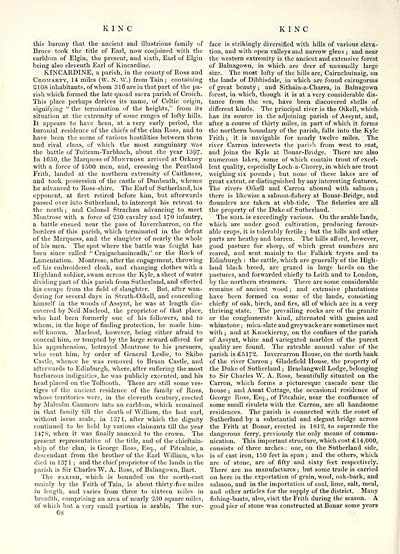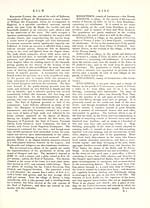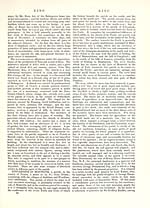Topographical dictionary of Scotland > Volume 2
(76) Page 68
Download files
Complete book:
Individual page:
Thumbnail gallery: Grid view | List view

KINC
KI NC
this barony that the ancient and illustrious family of
Bruce took the title of Earl, now conjoined with the
earldom of Elgin, the present, and sixth, Earl of Elgin
being also eleventh Earl of Kincardine.
KINCARDINE, a parish, in the county of Ross and
Cromarty, 14 miles (W. N. W.) from Tain ; containing
2108 inhabitants, of whom 316 are in that part of the pa-
rish which formed the late quoad sacra parish of Croich.
This place perhaps derives its name, of Celtic origin,
signifying " the termination of the heights," from its
situation at the extremity of some ranges of lofty hills.
It appears to have been, at a very early period, the
baronial residence of the chiefs of the clan Ross, and to
have been the scene of various hostilities between them
and rival clans, of which the most sanguinary was
the battle of Tuiteam-Tarbhach, about the year 1397.
In 1650, the Marquess of Montrose arrived at Orkney
with a force of 1500 men, and, crossing the Pentland
Frith, landed at the northern extremity of Caithness,
and took possession of the castle of Dunbeath, whence
he advanced to Ross-shire. The Earl of Sutherland, his
opponent, at first retired before him, but afterwards
passed over into Sutherland, to intercept his retreat to
the north ; and Colonel Strachan advancing to meet
Montrose with a force of 230 cavalry and 170 infantry,
a battle ensued near the pass of Invercharron, on the
borders of this parish, which terminated in the defeat
of the Marquess, and the slaughter of nearly the whole
of his men. The spot where the battle was fought has
been since called " Craigachaoineadh," or the Rock of
Lamentation. Montrose, after the engagement, throwing
off his embroidered cloak, and changing clothes with a
Highland soldier, swam across the Kyle, a sheet of water
dividing part of this parish from Sutherland, and effected
his escape from the field of slaughter. But, after wan-
dering for several days in Strath-Oikell, and concealing
himself in the woods of Assynt, he was at length dis-
covered by Neil Macleod, the proprietor of that place,
who had been formerly one of his followers, and to
■whom, in the hope of finding protection, he made him-
self known. Macleod, however, being either afraid to
conceal him, or tempted by the large reward offered for
his apprehension, betrayed Montrose to his pursuers,
who sent him, by order of General Leslie, to Skibo
Castle, whence he was removed to Braan Castle, and
afterwards to Edinburgh, where, after suffering the most
barbarous indignities, he was publicly executed, and his
head placed on the Tolbooth. There are still some ves-
tiges of the ancient residence of the family of Ross,
whose territories were, in the eleventh century, erected
by Malcolm Canmore into an earldom, which remained
iu that family till the death of William, the last earl,
without issue male, in 1371, after which the dignity
continued to be held by various claimants till the year
147S, when it was finally annexed to the crown. The
present representative of the title, and of the chieftain-
ship of the clan, is George Ross, Esq., of Pitcalnie, a
descendant from the brother of the Earl William, who
died in 1371 ; and the chief proprietor of the lands in the
parish is Sir Charles W. A. Ross, of Balnagown, Bart.
The parish, which is bounded on the north-east
mainly by the Frith of Tain, is about thirty-five miles
in length, and varies from three to sixteen miles in
breadth, comprising an area of nearly 230 square miles,
of which hut a very small portion is arable. The sur-
68
face is strikingly diversified with hills of various eleva-
tion, and with open valleys and narrow glens ; and near
the western extremity is the ancient and extensive forest
of Balnagown, in which are deer of unusually large
size. The most lofty of the hills are, Cairnchuinaig, on
the lands of Dibbisdale, in which are found cairngorms
of great beauty ; and Sithain-a-Charra, in Balnagown
forest, in which, though it is at a very considerable dis-
tance from the sea, have been discovered shells of
different kinds. The principal river is the Oikell, which
has its source in the adjoining parish of Assynt, and,
after a course of thirty miles, in part of which it forms
the northern boundary of the parish, falls into the Kyle
Frith ; it is navigable for nearly twelve miles. The
river Carron intersects the parish from west to east,
and joins the Kyle at Bonar-Bridge. There are also
numerous lakes, some of which contain trout of excel-
lent quality, especially Loch-a-Chorry, in which are trout
weighing six pounds ; but none of these lakes are of
great extent, or distinguished by any interesting features.
The rivers Oikell and Carron abound with salmon ;
there is likewise a salmon-fishery at Bonar-Bridge, and
flounders are taken at ebb-tide. The fisheries are all
the property of the Duke of Sutherland.
The soil is exceedingly various. On the arable lands,
which are under good cultivation, producing favour-
able crops, it is tolerably fertile ; but the hills and other
parts are heathy and barren. The hills afford, however,
good pasture for sheep, of which great numbers are
reared, and sent mainly to the Falkirk trysts and to
Edinburgh : the cattle, which are generally of the High-
land black breed, are grazed in large herds on the
pastures, and forwarded chiefly to Leith and to London,
by the northern steamers. There are some considerable
remains of ancient wood ; and extensive plantations
have been formed on some of the lands, consisting
chiefly of oak, birch, and firs, all of which are in a very
thriving state. The prevailing rocks are of the granite
or the conglomerate kind, alternated with gneiss and
whinstone ; mica-slate and greywacke are sometimes met
with ; and at Knockierny, on the confines of the parish
of Assynt, white and variegated marbles of the purest
quality are found. The rateable annual value of the
parish is £5 172. Invercarron House, on the north bank
of the river Carron ; Gladefield House, the property of
the Duke of Sutherland ; Braelangwell Lodge, belonging
to Sir Charles W. A. Ross, beautifully situated on the
Carron, which forms a picturesque cascade near the
house ; and Amat Cottage, the occasional residence of
George Ross, Esq., of Pitcalnie, near the confluence of
some small rivulets with the Carron, are all handsome
residences. The parish is connected with the coast of
Sutherland by a substantial and elegant bridge across
the Frith at Bonar, erected in 1812, to supersede the
dangerous ferry, previously the only means of commu-
nication. This important structure, which cost £ 14,000,
consists of three arches : one, on the Sutherland side,
is of cast iron, 150 feet in span ; and the others, which
are of stone, are of fifty and sixty feet respectively.
There are no manufactures ; but some trade is carried
on here in the exportation of grain, wool, oak-bark, and
salmon, and in the importation of coal, lime, salt, meal,
and other articles for the supply of the district. Many
fishing-boats, also, visit the Frith during the season. A
good pier of stone was constructed at Bonar some years
KI NC
this barony that the ancient and illustrious family of
Bruce took the title of Earl, now conjoined with the
earldom of Elgin, the present, and sixth, Earl of Elgin
being also eleventh Earl of Kincardine.
KINCARDINE, a parish, in the county of Ross and
Cromarty, 14 miles (W. N. W.) from Tain ; containing
2108 inhabitants, of whom 316 are in that part of the pa-
rish which formed the late quoad sacra parish of Croich.
This place perhaps derives its name, of Celtic origin,
signifying " the termination of the heights," from its
situation at the extremity of some ranges of lofty hills.
It appears to have been, at a very early period, the
baronial residence of the chiefs of the clan Ross, and to
have been the scene of various hostilities between them
and rival clans, of which the most sanguinary was
the battle of Tuiteam-Tarbhach, about the year 1397.
In 1650, the Marquess of Montrose arrived at Orkney
with a force of 1500 men, and, crossing the Pentland
Frith, landed at the northern extremity of Caithness,
and took possession of the castle of Dunbeath, whence
he advanced to Ross-shire. The Earl of Sutherland, his
opponent, at first retired before him, but afterwards
passed over into Sutherland, to intercept his retreat to
the north ; and Colonel Strachan advancing to meet
Montrose with a force of 230 cavalry and 170 infantry,
a battle ensued near the pass of Invercharron, on the
borders of this parish, which terminated in the defeat
of the Marquess, and the slaughter of nearly the whole
of his men. The spot where the battle was fought has
been since called " Craigachaoineadh," or the Rock of
Lamentation. Montrose, after the engagement, throwing
off his embroidered cloak, and changing clothes with a
Highland soldier, swam across the Kyle, a sheet of water
dividing part of this parish from Sutherland, and effected
his escape from the field of slaughter. But, after wan-
dering for several days in Strath-Oikell, and concealing
himself in the woods of Assynt, he was at length dis-
covered by Neil Macleod, the proprietor of that place,
who had been formerly one of his followers, and to
■whom, in the hope of finding protection, he made him-
self known. Macleod, however, being either afraid to
conceal him, or tempted by the large reward offered for
his apprehension, betrayed Montrose to his pursuers,
who sent him, by order of General Leslie, to Skibo
Castle, whence he was removed to Braan Castle, and
afterwards to Edinburgh, where, after suffering the most
barbarous indignities, he was publicly executed, and his
head placed on the Tolbooth. There are still some ves-
tiges of the ancient residence of the family of Ross,
whose territories were, in the eleventh century, erected
by Malcolm Canmore into an earldom, which remained
iu that family till the death of William, the last earl,
without issue male, in 1371, after which the dignity
continued to be held by various claimants till the year
147S, when it was finally annexed to the crown. The
present representative of the title, and of the chieftain-
ship of the clan, is George Ross, Esq., of Pitcalnie, a
descendant from the brother of the Earl William, who
died in 1371 ; and the chief proprietor of the lands in the
parish is Sir Charles W. A. Ross, of Balnagown, Bart.
The parish, which is bounded on the north-east
mainly by the Frith of Tain, is about thirty-five miles
in length, and varies from three to sixteen miles in
breadth, comprising an area of nearly 230 square miles,
of which hut a very small portion is arable. The sur-
68
face is strikingly diversified with hills of various eleva-
tion, and with open valleys and narrow glens ; and near
the western extremity is the ancient and extensive forest
of Balnagown, in which are deer of unusually large
size. The most lofty of the hills are, Cairnchuinaig, on
the lands of Dibbisdale, in which are found cairngorms
of great beauty ; and Sithain-a-Charra, in Balnagown
forest, in which, though it is at a very considerable dis-
tance from the sea, have been discovered shells of
different kinds. The principal river is the Oikell, which
has its source in the adjoining parish of Assynt, and,
after a course of thirty miles, in part of which it forms
the northern boundary of the parish, falls into the Kyle
Frith ; it is navigable for nearly twelve miles. The
river Carron intersects the parish from west to east,
and joins the Kyle at Bonar-Bridge. There are also
numerous lakes, some of which contain trout of excel-
lent quality, especially Loch-a-Chorry, in which are trout
weighing six pounds ; but none of these lakes are of
great extent, or distinguished by any interesting features.
The rivers Oikell and Carron abound with salmon ;
there is likewise a salmon-fishery at Bonar-Bridge, and
flounders are taken at ebb-tide. The fisheries are all
the property of the Duke of Sutherland.
The soil is exceedingly various. On the arable lands,
which are under good cultivation, producing favour-
able crops, it is tolerably fertile ; but the hills and other
parts are heathy and barren. The hills afford, however,
good pasture for sheep, of which great numbers are
reared, and sent mainly to the Falkirk trysts and to
Edinburgh : the cattle, which are generally of the High-
land black breed, are grazed in large herds on the
pastures, and forwarded chiefly to Leith and to London,
by the northern steamers. There are some considerable
remains of ancient wood ; and extensive plantations
have been formed on some of the lands, consisting
chiefly of oak, birch, and firs, all of which are in a very
thriving state. The prevailing rocks are of the granite
or the conglomerate kind, alternated with gneiss and
whinstone ; mica-slate and greywacke are sometimes met
with ; and at Knockierny, on the confines of the parish
of Assynt, white and variegated marbles of the purest
quality are found. The rateable annual value of the
parish is £5 172. Invercarron House, on the north bank
of the river Carron ; Gladefield House, the property of
the Duke of Sutherland ; Braelangwell Lodge, belonging
to Sir Charles W. A. Ross, beautifully situated on the
Carron, which forms a picturesque cascade near the
house ; and Amat Cottage, the occasional residence of
George Ross, Esq., of Pitcalnie, near the confluence of
some small rivulets with the Carron, are all handsome
residences. The parish is connected with the coast of
Sutherland by a substantial and elegant bridge across
the Frith at Bonar, erected in 1812, to supersede the
dangerous ferry, previously the only means of commu-
nication. This important structure, which cost £ 14,000,
consists of three arches : one, on the Sutherland side,
is of cast iron, 150 feet in span ; and the others, which
are of stone, are of fifty and sixty feet respectively.
There are no manufactures ; but some trade is carried
on here in the exportation of grain, wool, oak-bark, and
salmon, and in the importation of coal, lime, salt, meal,
and other articles for the supply of the district. Many
fishing-boats, also, visit the Frith during the season. A
good pier of stone was constructed at Bonar some years
Set display mode to: Large image | Transcription
Images and transcriptions on this page, including medium image downloads, may be used under the Creative Commons Attribution 4.0 International Licence unless otherwise stated. ![]()
| Gazetteers of Scotland, 1803-1901 > Topographical dictionary of Scotland > Volume 2 > (76) Page 68 |
|---|
| Permanent URL | https://digital.nls.uk/97362041 |
|---|
| Description | Volume II: From Keanlochbervie to Zetland. |
|---|---|
| Attribution and copyright: |
|

